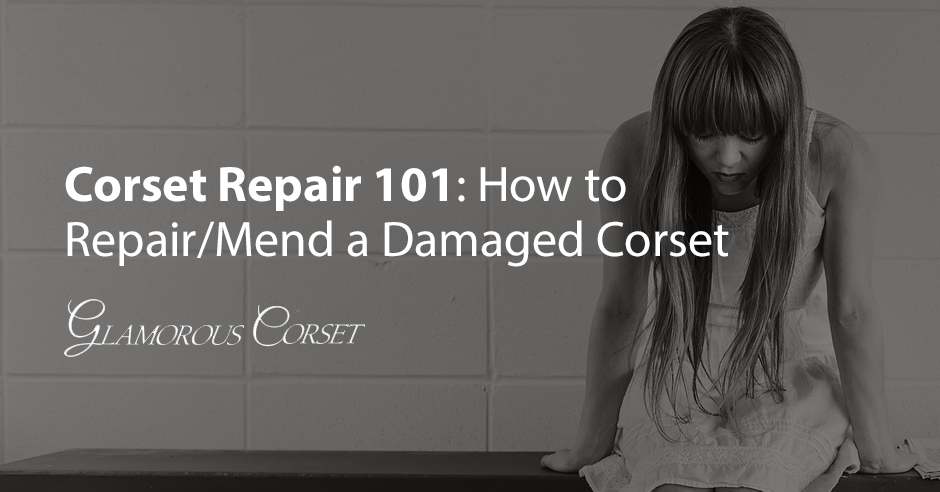Blog
Corset Repair 101: How to Repair/Mend a Damaged Corset
When you first strap on your steel boned corset, it may seem well-nigh indestructible. Those sturdy steel bones! The reinforced channels! Textiles and hardware seemingly designed to stop ballistic missiles! There’s just no denying proper waist training corsets are made to stand up to the abuses you heap on them in your quest for a Scarlet O’Hara-sized waistline.
Unfortunately, corsets are garments like any other. While they’re intended to take more stress than the average garment and hold up to daily wear and lace tightening, and they’ll last a good long while with proper usage and care, there are going to be times when you suffer an epic fail like a torn seam, a broken busk or grommet, or boning that springs free of its channel and tries to escape, or worse, skewer your midsection.
When such incidents occur, it doesn’t mean you have to toss out your pricy and well-seasoned shapewear. You can do repairs to mend damaged areas and continue enjoying use of your favorite corsets for years to come. It’s not a sock that will cost you a couple bucks to replace – it’s a customized garment that you’ve worked hard to conform to your precise curves and you want to get the most out of it! With the right care, you could have a longer relationship with your corset than any single boyfriend (or several).
Don’t fret if you see a fraying edge or loose hardware. There are simple ways to repair your corset without breaking a sweat. Here are the basics of corset repair for anyone looking to get more longevity from these gorgeous garments.
Fabric Tears or Frayed Seams
The hardware on your corset is bound to be made from durable metals, such as strong and resilient steel, for example. The textiles used in corsetry tend to be sturdy, as well, but if something’s going to go, there’s a good bet the fabric and seams will be first to malfunction.
Torn seams are not entirely uncommon, especially with age. They can also occur if you don’t learn how to properly season your garment and waist train incrementally (i.e. you tighten too much, too fast). Your ability to mend this issue may depend entirely on the scope of the damage.
If, for example, you simply bust the stitching on the seam, you’re looking at a relatively easy repair. All you have to do is re-stitch the area using a quick and secure whipstitch. It will be visible, of course, but it should do the trick.
If your nitpicky nature won’t allow you to leave this visible sign of mending, or the damage is more extensive (such as a tear in the fabric at the seam), you’re in for a lot more work. You’ll have to take the garment layers apart, utilize seam allowances (if any) to hide the damage, and then reassemble your corset in an hours-long expedition into the inner workings of your garment. This could also change the shape of the garment slightly, depending on how much of the seam allowance you’re forced to use.
If steel boning wears a hole in the fabric channel and breaks through, a simple patch job can fix it, but for invisible mending, you’ll have to sew on a new external boning channel. Since matching fabric can be nearly impossible, this could mean sewing new external channels over every bone for a cohesive appearance. On the upside, all of your channels will now be reinforced.
Broken Hardware
It’s rare for hardware to break, especially before the fabric or seams give out, but it’s not entirely unheard of. Luckily, many hardware issues are easily rectified. If, for example, a steel bone somehow bends or breaks, all you have to do is remove the binding edge near the channel, extract the broken steel bone, and use it to get an accurate measurement so you can order a replacement from your corsetiere.
Replacing broken busks can be a bit more complex. You’ll have to decide if you want to try to replace a single broken peg, which requires specific tools (a rivet setter, for example) or simply replace the entire busk. If you opt for the latter, keep in mind that removing and replace hardware could cause some damage to the fabric and leave visible signs of repair, especially in textiles like leather that aren’t self-healing.
Grommets are relatively easy to replace, but you may have trouble finding matching replacement hardware. Your best bet here is to contact your corsetiere to see if they have extras on hand they can send you.
Professional Help
Not everyone feels comfortable taking on corset repairs on their own. If you don’t consider yourself a seamstress and you worry you’ll do more harm than good, contact your corsetiere for advice. They may offer repair services or they could recommend professionals that specialize in corset repair. If all else fails, visit a reputable alterations shop in your area for assistance.
Stay up-to-date with weekly blog posts, waist training tips, and the chance to win one of our monthly corset giveaways, like us on Facebook & subscribe to our mailing list today! Want to find the perfect steel boned corset? Shop some of our favorites: underbust corsets, overbust corsets, corset dresses.

My name is Rachel, I am the owner of Glamorous Corset, a small business founded by me in 2010. Back In 2005, I was in a car accident that left me with a herniated disk. Much to my surprise I learned steel boned corsets were beneficial to several medical injuries including mine. I was always intrigued with corsetry, their history and their beautiful aesthetic. I love sharing knowledge about corsets, educating my wonderful readers and breaking the negative stigma related to corsetry. In combination with my years of research and personal experience I hope my articles are useful and can help anyone who has struggled with some of the same things I have. More about me…


